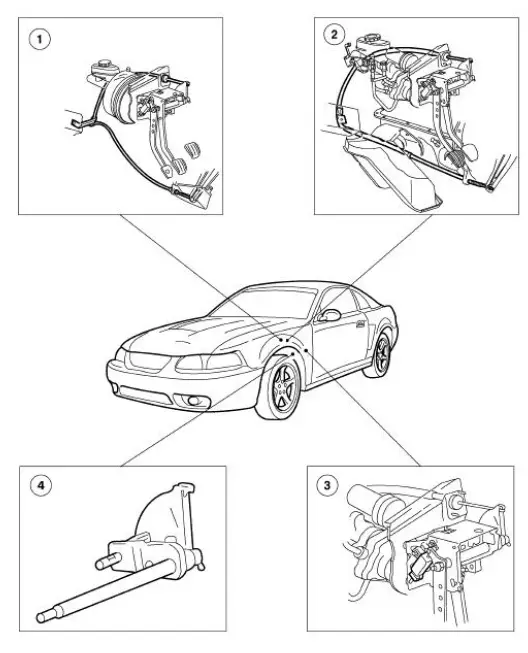Ford Mustang (1999-2004) Service Manual: Clutch Controls (Description and Operation)



The clutch control system engages and disengages the clutch. The clutch control system disengages the clutch when the clutch pedal is depressed and engages the clutch when the clutch pedal is released. Clutch pedal motion is transmitted by the clutch release lever cable to the clutch release lever. The clutch release hub and bearing engages the clutch pressure plate diaphragm spring, releasing the pressure on the clutch disc which in turn disengages the transmission from the engine.
The clutch adjusts automatically to compensate for clutch disc wear. The clutch linkage is selfadjusting.
The clutch pedal position (CPP) switch prevents the starter motor from engaging unless the clutch pedal is depressed all the way to the floor. The switch plunger is contacted by the clutch pedal and extends as the clutch pedal is pressed. The clutch pedal position switch is electrically connected in line with the ignition switch and the starter motor relay coil. The CPP also turns off the speed control when the clutch pedal is depressed.
 Clutch Controls
Clutch Controls
General Specifications
Torque Specifications
...
 Clutch Pedal - Quadrant and Pawl Assembly
Clutch Pedal - Quadrant and Pawl Assembly
Removal
1. Disconnect the battery ground cable (14301).
2. Loosen the nut from inside the engine compartment.
3. Loosen the nuts from inside the vehicle.
4. Loosen the screw.
5. Disconnect t ...
Other materials:
Inspection and Verification
1. Verify the customer's concern by operating the active restraint system to
duplicate the condition.
2. Inspect to determine if any of the following mechanical or electrical
concerns apply:
Visual Inspection Chart
Mechanical
Electrical
...
Pinpoint Test P: No Communication With The Restraints Control Module
Normal Operation
The RCM communicates with the scan tool using ISO 9141 communication mode
through the data link
connector (DLC).
Possible Causes
A no communication condition can be caused by:
damage to circuit 70 (LB/WH).
a damaged DLC.
a damage ...
Air Bag Supplemental Restraint System (SRS) (Description and Operation)
The air bag supplemental restraint system (SRS) is designed to provide
increased collision protection
for front seat occupants in addition to that provided by the three-point safety
belt system. Safety belt
use is necessary to obtain the best occupant protec ...
